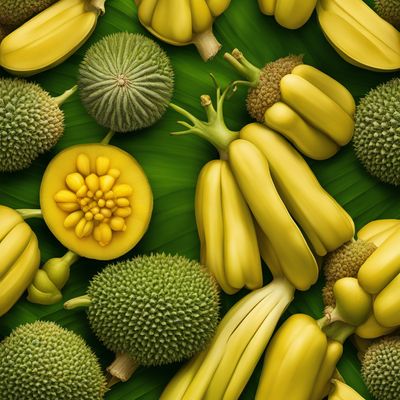
Ingredient
Breadfruits and similar-
The Tropical Treasure: Breadfruits and Similar
Breadfruits and similar fruits have a green, bumpy skin and a starchy, creamy flesh that becomes soft and tender when cooked. They have a subtle sweetness and a mild flavor that pairs well with both savory and sweet ingredients. When ripe, their flesh turns yellow and becomes sweeter, making them perfect for desserts. These fruits can be roasted, boiled, fried, or even grilled, offering endless possibilities in the kitchen.
Origins and history
Breadfruits are believed to have originated in the South Pacific and were later introduced to other tropical regions around the world. They have been a staple food in many cultures for centuries, providing a reliable source of carbohydrates. Breadfruits gained prominence during the era of European exploration, as they were considered a valuable food source for sailors on long voyages. Today, they are cultivated in various tropical regions and are enjoyed in a wide range of cuisines.
Nutritional information
Breadfruits and similar fruits are a good source of dietary fiber, vitamin C, and potassium. They are low in fat and cholesterol, making them a healthy choice for those watching their weight or managing their cholesterol levels. Additionally, they contain antioxidants that help protect the body against oxidative stress and inflammation.
How to select
When selecting breadfruits and similar fruits, choose ones that are firm and free from any blemishes or bruises. The skin should be green and intact, without any signs of mold or decay. Avoid fruits that are too soft or have a strong odor, as this may indicate overripeness. If possible, opt for organic or locally grown fruits for the best flavor and quality.
Storage recommendations
To store breadfruits and similar fruits, keep them at room temperature until they are fully ripe. Once ripe, they can be stored in the refrigerator for up to a week. If you have cut or peeled the fruit, wrap it tightly in plastic wrap or place it in an airtight container to prevent moisture loss. Cooked breadfruit can be stored in the refrigerator for 2 to 3 days.
How to produce
Breadfruit trees can be grown in tropical or subtropical regions with a warm climate. They require well-drained soil and regular watering. It is recommended to plant them in a sunny location with protection from strong winds. Breadfruit trees can be propagated from seeds or by grafting. However, keep in mind that they may take several years to bear fruit.
Preparation tips
Breadfruits and similar fruits can be prepared in various ways depending on their ripeness. When unripe, they can be boiled, roasted, or fried to create savory dishes like breadfruit chips or curries. Ripe breadfruits are often used in desserts, such as breadfruit pudding or fritters. They can also be mashed or pureed and used as a substitute for potatoes in recipes like breadfruit gnocchi or breadfruit fries. Experiment with different cooking techniques to discover your favorite way to enjoy these tropical treasures!
Culinary uses
Breadfruits and similar fruits are used in a variety of cuisines around the world. In Caribbean cuisine, they are a staple ingredient and are often used in dishes like breadfruit and saltfish or breadfruit salad. In Pacific Island cuisines, they are traditionally cooked in an underground oven called an umu. They can also be used in soups, stews, and even as a pizza topping. Additionally, ripe breadfruits are commonly used in desserts like pies, cakes, and puddings.
Availability
Breadfruits and similar fruits are commonly available in tropical regions, including the Caribbean, Pacific Islands, Southeast Asia, and parts of Africa. They can be found in local markets, grocery stores, and specialty food stores in these regions. However, their availability may be limited in other parts of the world.

